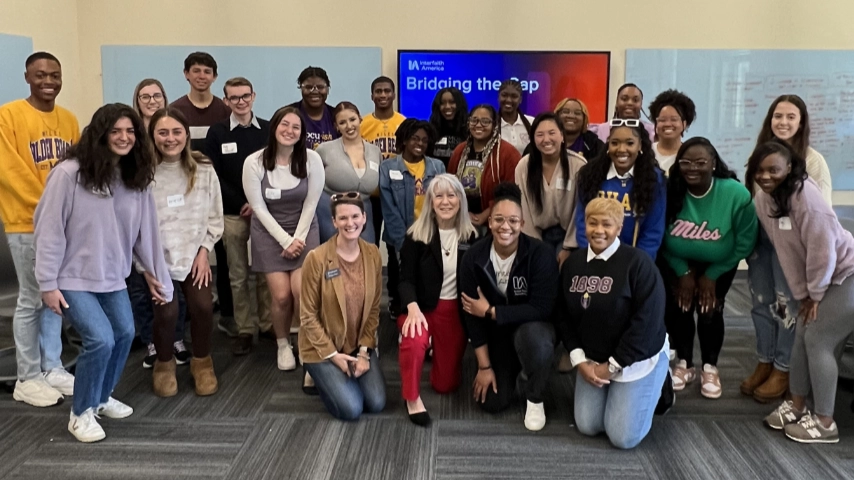
In August 2022, representatives from Samford University and Miles College attended the Interfaith Leadership Summit in Chicago to be a part of a cohort that Interfaith America had sponsored for the Bridging the Gap initiative. At this meeting, the idea of partnership was fleshed out, and the two institutions agreed to put together a grant proposal. This ultimately led to Miles and Samford receiving Interfaith America’s first educational impact grant in the amount of $25,000.
Interfaith America is a national nonprofit organization that believes religious diversity is a foundational American strength. Its mission is to inspire, equip and connect leaders and institutions to unlock the potential of America’s religious diversity.
In December, Samford and Miles kicked off their partnership with a special campus experience, where plans to offer courses on bridging the gap at each school were shared with the community.
Since then, Samford and Miles have each sought to educate students with a curriculum unique to Interfaith America’s Bridging the Gap initiative, which helps students engage in constructive and healthy dialogue surrounding difficult subjects. These courses have allowed students to connect with one another and build relationships.
“The Bridging the Gap program is designed to combat polarization in our country and give students the skills they need to find common ground across deep divides. In a time of intense and often hostile political and social polarization, we must build the capacity to bridge the gap of our differences to understand one another and work together toward common good solutions,” said Anna McEwan, dean of Orlean Beeson School of Education and one of the Bridging the Gap course instructors.
In January, both institutions launched their Bridging the Gap courses. At Samford, McEwan and Bridget Rose, director of the Academic Success Center, co-lead this course, the first of its kind at Samford.
“It is clear that this was a self-selecting group. Students enrolled in the course because they cared about the topic. The students demonstrate their own commitment to and interest in bridge-building and related skills. Many of the students were already involved in campus organizations or other initiatives that allowed them to incorporate this course content into that work,” said Rose.
The course is a leadership opportunity for students interested in civil discourse and how to thoughtfully engage others, even when we disagree. Practical skills are taught and refined for participating students that will positively impact their ability to be successful in a wide array of environments, both professionally and personally.
“I chose to be a part of Bridging the Gap because I believe that no matter where you are from, all of our ideas can correlate with each other and make an impact in this world. At the end of the day, it is all about coming together and making a difference,” said Konner Price, a student at Miles College, from Dallas, Texas.
On March 16, the two cohorts of bridging the gap students came together on Samford’s campus for a joint session and dinner. This marks the first time the two cohorts have gathered in person to share what they have been learning and participate in activities that put their education to the test.
“This was an ‘encounter week,’ as we call them,” said Rose. “It was the first formal opportunity the students had to meet each other and begin to put into practice the skills of listening and storytelling they had learned in the course.
At this session, students engaged in several activities. Activities like “lay it on the line,” where a facilitator reads a statement and students “lay their opinion on the line” by standing in certain areas of the room and discussing their disagreements amongst themselves.
“I found the listening exercise really surprising,” said Annie Kelley, a Samford student participating in the course. “We were taught four steps on how we engage in conversation, and how you can be an active listener, unconcerned with yourself and focused on the person speaking. Our knee-jerk reaction is to provide feedback and, in some cases, fight our corner, but listening is key to having constructive and impactful conversations.”
This partnership between Miles College and Samford University has brought the institutions and their students closer together for collaborative learning and community involvement in Birmingham. Students in the two cohorts plan to continue meeting together as they enter the next phase in the coursework.
“I believe every school has its unique components that make it special. It is a blessing to me to be a part of these two schools coming together and discovering their commonalities and their differences,” said Price.
Students have already moved into the next phase of the curriculum, which involves a project of their choosing to apply some of the skills they have learned about and acquired. Some students have taken to social media, working with multicultural student organizations, developing training modules, and more to educate others on the importance of bridging the gap.
“I was incredibly grateful to see what thoughtful students we have who are emerging as campus and cultural leaders on important issues. While we can always work on the ’plans‘ for a course or an event, it takes the energy and ideas and engagement of the students to make a course like this work. And they brought all those things and more to the table,” said Rose.
